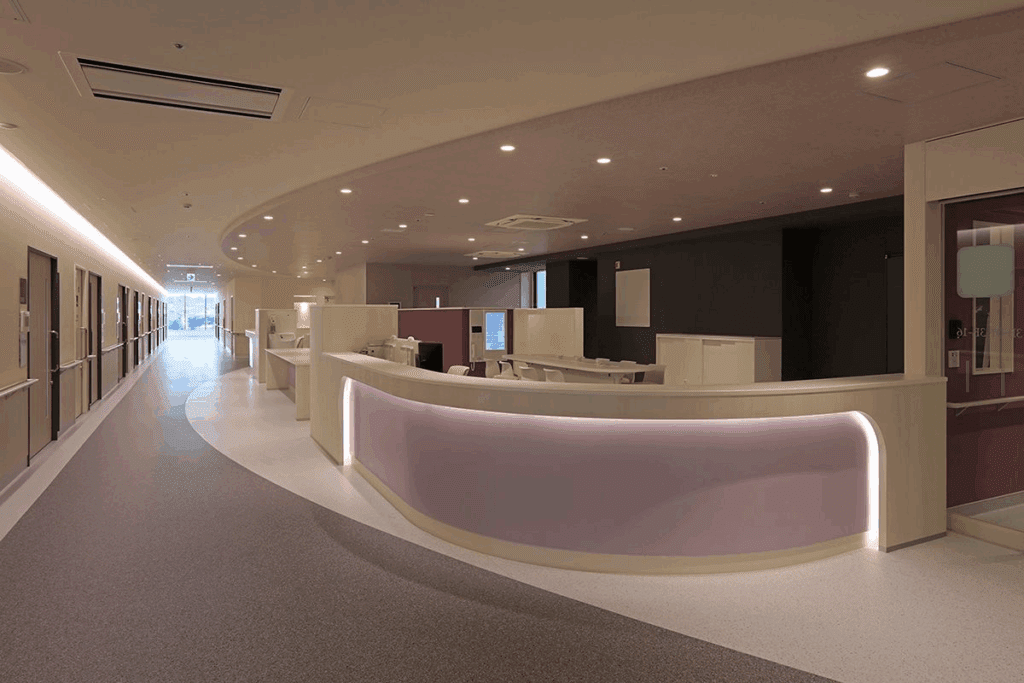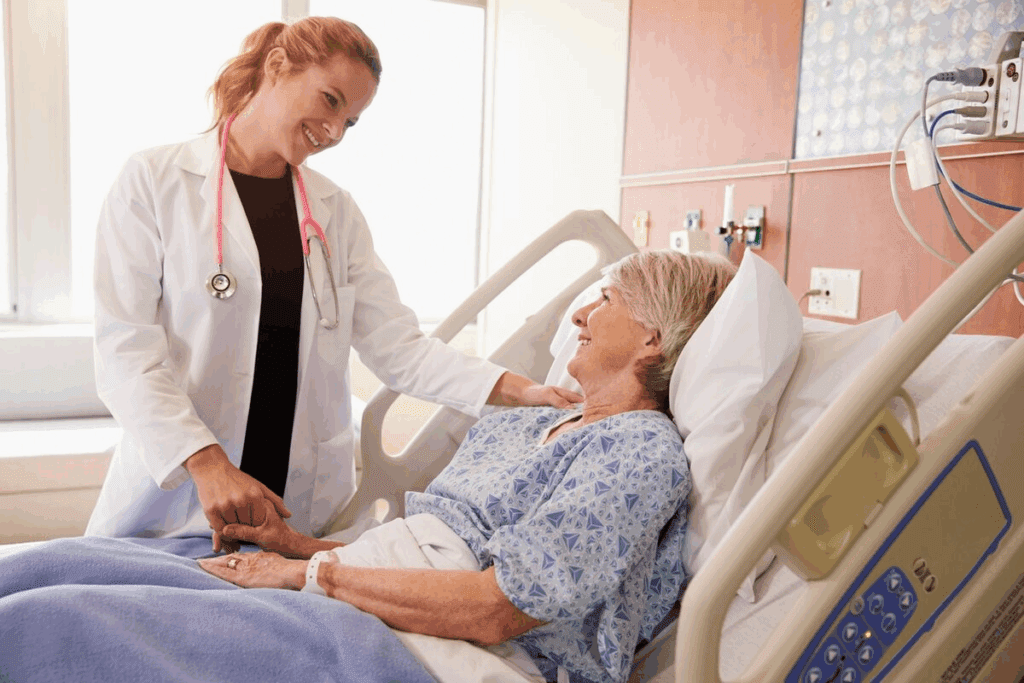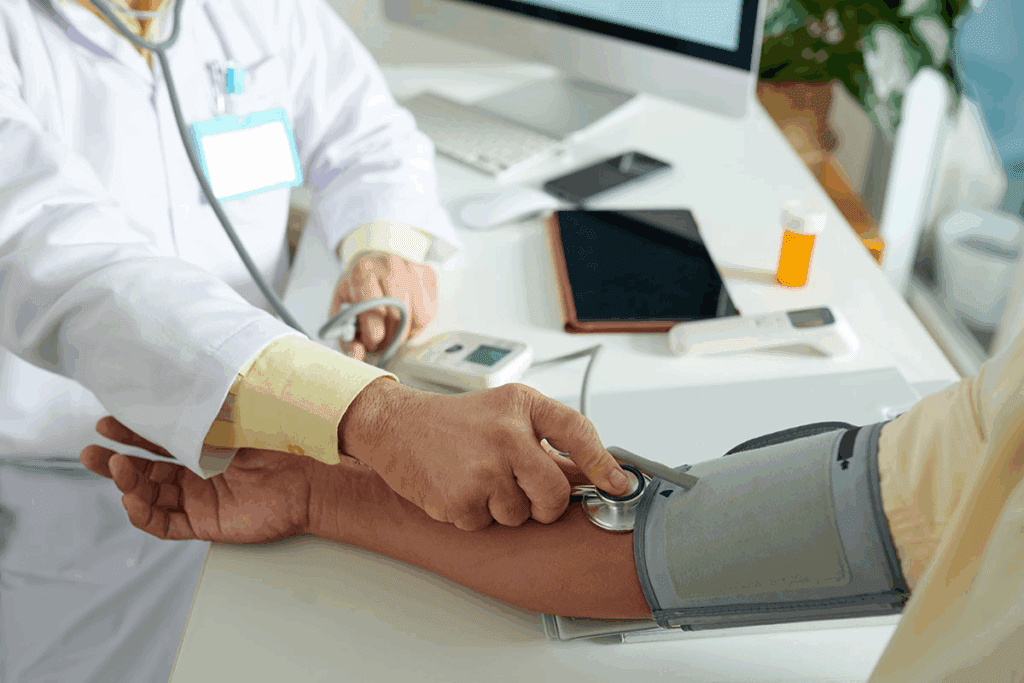Last Updated on October 31, 2025 by Saadet Demir

It’s important to know the difference between lymphoid nodules and lymph nodes. They are key parts of our immune system and health. You might see these terms in medical books, but they mean different things.
Lymphoid nodules are small groups of immune cells found under skin or lining. They help fight off germs. On the other hand, lymph nodes are bigger and help filter out bad stuff from our body’s fluids.
At places like Liv Hospital, we stress the need to understand these differences. Knowing how lymphoid nodules and lymph nodes work helps us take better care of our health.

The lymphatic system is vital for our health and fighting off infections. It helps protect the body from diseases.
The lymphatic system has important parts like lymph nodes and vessels. Lymph nodes filter lymph fluid and fight off pathogens. Lymphoid nodules are smaller groups of immune cells found in the body.
Lymphatic vessels carry lymph fluid around the body. They help move immune cells and remove waste.
The lymphatic system is key for our immune system. It helps activate immune cells to fight off infections.
“The lymphatic system’s role in immune defense is multifaceted, involving the filtration of lymph fluid, the activation of immune cells, and the production of antibodies.”
Lymphatic circulation moves lymph fluid through vessels back to the bloodstream. It’s important for fluid balance and immune response.
Understanding the lymphatic system shows how it protects us. Its parts and functions work together for our immune defense.

Lymphoid nodules are key parts of our immune system. They help fight off infections in different parts of our body. You can find them in places like our gut and lungs.
These nodules start the fight against germs. They are filled with immune cells called lymphocytes and macrophages. Unlike lymph nodes, they don’t have a clear outer layer.
Lymphoid nodules play a big role in keeping us healthy. In our gut, they help fight off bad stuff we eat. In our lungs, they protect us from germs we breathe in.
To understand lymphoid nodules better, let’s look at some important facts in the table below:
| Characteristics | Description | Significance |
| Location | Found in various parts of the body, including the gastrointestinal tract and respiratory system | Provides localized immune responses |
| Structure | Lack a defined connective-tissue capsule | Distinguishes them from lymph nodes |
| Cellular Composition | Contain dense masses of lymphocytes and macrophages | Vital for immune response initiation |
Knowing about lymphoid nodules helps us see their importance in our immune system. They are vital for fighting off infections in specific areas of our body.
Lymphoid nodules are key to the lymphatic system’s function. They have unique cells and structures.
Dense masses of lymphocytes and macrophages are found in lymphoid nodules. These cells are packed tightly. This helps them work together well.
Lymphocytes, like B and T cells, are important for fighting off invaders. They recognize and attack harmful substances.
Macrophages help by eating up foreign particles and germs. They play a big role in the innate immune response.
Lymphoid nodules don’t have a clear connective-tissue capsule. This makes them flexible and able to move around in the body. They are often found in places where germs can easily get in.
Without a capsule, lymphoid nodules can blend in with the tissue around them. This helps them fight off infections right where they happen.
The way lymphoid nodules are organized helps them work better. The close packing of cells lets them talk to each other easily. This is important for starting and managing immune responses.
The structure of lymphoid nodules also helps the immune system fight off infections. It makes sure the immune response happens where it’s needed most.
Lymph nodes are key in our immune system. They are shaped like kidneys and help filter lymph. This supports our immune system’s work.
Lymph nodes have a special structure. They are wrapped in a tough layer of connective tissue. This layer protects and supports the lymphoid tissue inside.
Inside, lymph nodes have two main parts: the cortex and the medulla. The cortex has outer and inner parts. The outer part has B cells, and the inner part has T cells.
The medulla is the center. It has cords and sinuses that help filter lymph.
Lymph nodes connect to the lymphatic system. Afferent lymphatic vessels bring lymph in. Efferent lymphatic vessels take filtered lymph out.
This connection is key for filtering lymph and starting immune responses.
| Region | Characteristics | Function |
| Cortex | Contains lymphoid follicles and paracortex | Primarily involved in B cell and T cell responses |
| Medulla | Contains medullary cords and sinuses | Critical for lymph filtration and plasma cell formation |
| Afferent Lymphatic Vessels | Bring lymph into the lymph node | Essential for lymph node filtration function |
| Efferent Lymphatic Vessels | Carry filtered lymph out of the lymph node | Important for circulating filtered lymph throughout the body |
Lymphoid nodules and lymph nodes are key to our immune system. They differ in size, structure, and where they are found. Knowing these differences helps us understand their roles in fighting off infections.
Lymphoid nodules are smaller and more varied than lymph nodes. Lymph nodes are bean-shaped and usually the same size, ranging from a few millimeters to 1-2 centimeters.
Key size differences include:
Lymphoid nodules and lymph nodes have different structures. Lymph nodes have a clear outer layer, a middle part, and an inner part. Lymphoid nodules don’t have these clear layers.
Key structural differences:
Lymphoid nodules are found in many places in the body. They are often in areas like the gut, lungs, and other places where they can meet antigens.
Notable locations for lymphoid nodules include:
Lymph nodes are linked to lymphatic vessels. They have vessels that help filter and process lymph. Lymphoid nodules don’t have this direct connection.
Key differences in their relationship to lymphatic vessels:
Lymphoid nodules are key in starting immune responses in specific body areas. They are vital for local immune responses, helping protect us from harm.
Lymphoid nodules help create local immune responses. This lets our body fight off infections right where they start. It’s important to stop infections from spreading.
These nodules are found in places like the gut and lungs. They help our immune system act fast against invaders.
Lymphoid nodules are also important for B-cell development and antibody production. B-cells grow here and turn into cells that make antibodies when they meet antigens.
This process is key to our humoral immunity. It helps us fight off pathogens by recognizing and neutralizing them.
Lymphoid nodules interact with surrounding tissues. This interaction is important for coordinating immune responses. It makes sure our immune reaction is right for the threat.
By talking to other parts of the immune system, lymphoid nodules help us fight off infections well.
In summary, lymphoid nodules are vital for a strong immune response. They help with local responses, B-cell growth, and talking to other tissues. This shows how important they are for our immunity.
Lymph nodes are key organs that filter lymph fluid. They trap pathogens and activate immune cells. This is vital for our immune system to fight off infections.
They filter interstitial fluid and help in immune responses. We’ll look at how they do this. This includes filtration, antigen processing, lymphocyte activation, and supporting immune cell interactions.
Lymph nodes are found all over the body. They filter interstitial fluid, which becomes lymph fluid in lymphatic vessels. This fluid can have pathogens and foreign substances.
As lymph fluid goes through a lymph node, it gets filtered. This removes harmful entities.
The lymph node’s structure helps in this process. It has reticular fibers and cells like macrophages and dendritic cells. These work together to trap and process antigens.
Antigens trapped in a lymph node are processed and presented to lymphocytes. Antigen-presenting cells like dendritic cells and macrophages engulf and digest antigens. They break them down into smaller peptides.
These peptides are then shown on the surface of APCs via MHC molecules. This is a key step in starting an immune response.
T-cells, in particular, recognize and respond to these antigens. This leads to their activation and proliferation.
Lymphocytes getting activated in lymph nodes is a critical part of the immune response. When T-cells see antigens presented by APCs, they get activated. They start to multiply.
This multiplication leads to more T-cells that can fight the pathogen or foreign substance. B-cells also get activated and proliferate, often with T-cell help. They become antibody-secreting plasma cells.
These plasma cells produce antibodies specific to the antigen. These antibodies help neutralize or remove the antigen from the body.
The structure of a lymph node supports immune cell interactions. Its architecture, including the cortex and medulla, aids in immune responses.
| Function | Description | Key Cells Involved |
| Filtration | Removal of pathogens and foreign substances from lymph fluid | Macrophages, Dendritic Cells |
| Antigen Processing and Presentation | Processing and presenting antigens to lymphocytes | Dendritic Cells, Macrophages |
| Lymphocyte Activation and Proliferation | Activation and clonal expansion of antigen-specific lymphocytes | T-cells, B-cells |
| Structural Matrix | Providing a supportive environment for immune cell interactions | Reticular Fibers, Various Immune Cells |
In summary, lymph nodes are essential for our immune system. They filter fluid, process antigens, activate lymphocytes, and support immune cell interactions. Understanding these roles helps us appreciate how our immune system defends us.
Lymphoid nodules are found in many parts of our body. They help our immune system work well. These nodules are spread out across different systems, playing a big role in keeping us healthy.
In the gastrointestinal tract, lymphoid nodules are very common. They form structures like Peyer’s patches in the small intestine. These are key for watching over the gut and starting immune responses against harmful invaders.
MALT is a big part of our immune system. It’s found on mucosal surfaces all over the body. This includes the gut, as well as the respiratory and genitourinary tracts. MALT helps keep these areas safe from infections.
The respiratory tract also has lymphoid nodules. These help filter the air we breathe and fight off pathogens we inhale. Having lymphoid tissue in the respiratory tract is essential for our lung health.
Lymphoid nodules are also found in other important places. This includes the spleen and lymph nodes. These locations show how widespread and vital lymphoid nodules are for our immune system.
| Location | Function | Significance |
| Gastrointestinal Tract | Immune surveillance and response | Critical for gut health |
| MALT | Mucosal immunity | Protects mucosal surfaces |
| Respiratory Tract | Filtering and immune response | Vital for respiratory health |
Imaging techniques are key in finding and studying lymphoid nodules and nodes. Seeing these structures is vital for diagnosing and treating lymphatic system issues.
Radiological methods are essential for spotting and studying lymphoid structures. Ultrasound and CT scans help see lymph nodes and check their size and shape. They spot problems like swelling or shape changes that might mean disease.
Ultrasound is great for looking at surface lymph nodes, giving clear images to tell if something is wrong. CT scans, though, show a wider view, letting doctors check nodes all over the body, like in the belly and chest.
Looking at tissue samples under a microscope is key for studying lymphoid structures. Pathologists can see cell details and patterns in lymph nodes and nodules. This helps diagnose diseases, infections, and cancers.
To do this, doctors take tissue samples through biopsies or surgery. Then, they stain and process the tissues. H&E staining and immunohistochemistry help show cell details and find specific markers.
New imaging tools have made it easier to find and study lymphoid structures. PET (Positron Emission Tomography) scans and MRI (Magnetic Resonance Imaging) are top-notch methods. PET scans are great for seeing how active lymph nodes are, helping find cancer.
MRI gives detailed images of lymph nodes and the tissues around them. It’s super useful for checking nodes in tricky spots, like the neck and pelvis.
Using these imaging methods together, doctors get a full picture of lymphoid structures. This helps them diagnose and treat many lymphatic system problems.
It’s key to know how lymphoid nodules and lymph nodes work for diagnosing and treating diseases. These parts are vital to our immune system. If they don’t work right, it can cause many illnesses.
Lymphoid nodules and lymph nodes can show up differently when sick. Usually, they’re not big and don’t hurt when touched. But, if they get big and hurt, it means something’s wrong.
Abnormal presentations can happen for many reasons. This includes infections, autoimmune diseases, and cancers. For example, lymphoid hyperplasia makes these tissues bigger because of long-term infection or inflammation.
Lymphoid hyperplasia means there are more lymphoid cells because of something they’re fighting. This can be a normal reaction that goes away when the cause is fixed. But, it can also lead to more serious problems.
Inflammation of these structures is called lymphadenitis. It can be short-term or long-term. Short-term is often from bacteria, while long-term can be from things like tuberculosis or autoimmune diseases.
Lymphoid nodules and lymph nodes can get cancer, like lymphomas and leukemias. These cancers grow from too many lymphoid cells and can make lymph nodes big. This is just one symptom.
Diagnosing cancers in these areas needs a full check-up, scans, and looking at tissue samples.
Figuring out what’s wrong with lymphoid nodules and lymph nodes takes a lot of steps. This includes talking to the patient, checking them physically, doing scans, and lab tests. Treatment varies based on the cause. It can be simple treatments like antibiotics or more serious like chemo or radiation for cancer.
It’s very important for doctors to understand the clinical relevance of these structures. This helps them make the right diagnosis and treatment plan.
It’s important to know the difference between lymphoid nodules and lymph nodes. They both help the immune system, but in different ways. Each has its own role and function.
We’ve looked at the basics of the lymphatic system. We’ve also talked about what lymphoid nodules and lymph nodes are made of. We’ve seen how they work together to keep us healthy.
The immune system uses lymphoid nodules and lymph nodes to fight off infections. They help filter fluids and get lymphocytes ready to fight. Knowing about these parts helps us see how they keep us safe.
To sum up, lymphoid nodules and lymph nodes are key to our immune system. They work together to keep us safe from sickness. Their unique roles show how complex and smart our immune system is.
A lymphoid nodule is a small group of immune cells. It’s important for the immune system, helping with local defenses.
Lymphoid nodules are small and not covered by a membrane. Lymph nodes are bigger and have a membrane. They both help the immune system but in different ways.
Lymphoid nodules help with local defenses and B-cell development. They also aid in making antibodies, boosting the immune system.
Lymphoid nodules are in many places. You can find them in the gut, respiratory tract, and more.
Lymph nodes catch pathogens and other foreign stuff. This lets immune cells deal with threats.
Lymph nodes help immune cells work together. They support the activation and coordination of immune responses.
They can be seen with radiology, histology, and imaging like ultrasound and MRI. This helps doctors understand their structure and function.
Problems with lymphoid structures can mean inflammation or cancer. They need to be diagnosed and treated properly.
Lymphoid nodules in MALT are key for mucosal immunity. They help fight off pathogens at mucosal surfaces.
Lymphoid nodules support B-cell growth and antibody making. They provide a place for B-cells to become antibody-secreting plasma cells.
World Health Organization. (2025). What Are Lymphoid Nodules and How Do They. Retrieved from https://www.who.int/news-room/q-and-a/detail/q-a-on-coronaviruses-(covid-19))
Subscribe to our e-newsletter to stay informed about the latest innovations in the world of health and exclusive offers!
WhatsApp us